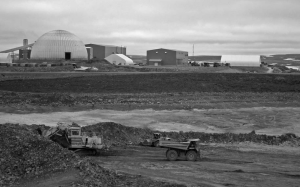VANCOUVER — Agnico-Eagle Mines (AEM-T, AEM-N) reached record gold production, revenue and net income in the third quarter, the result of several years of work commissioning no less than five mines.
Net income was US$121.5 million, compared with a net loss of US$17 million for the same period a year ago. Total revenue for the quarter was US$473 million, compared to US$159 million for the same quarter in 2009, thanks in part to both increased production and significantly higher metal prices.
Gold production was up 140% to 285,179 oz., while the company expects to produce between 1 million and 1.1 million oz. gold this year.
Sean Boyd, vice-chairman and CEO of Agnico-Eagle, said in a phone interview that the company is benefitting from years of expansion, often at a demanding rate.
“The sheer pace of trying to build five mines at the same time from scratch, that wasn’t easy,” says Boyd. “We do our own feasibility studies; we’re our own general contractor, so we take on a fair bit when we build these things. It’s pretty hard to build two or three; when you’re building five, it gets a bit wild and willy. But it was the right thing to do because we built a lot of value.”
Production increased from last year thanks to recoveries of 81% at the Kittila gold mine in Finland compared with 64% in the same quarter last year, as well as by achieving commercial production at the Pinos Altos gold mine in Mexico last November and the sizable Meadowbank gold mine in Nunavut earlier this year. Agnico-Eagle also continued to reap strong outputs from its three mines in the Abitibi region of Quebec.
Total cash costs per oz. were US$441, compared with US$436 for the same quarter a year earlier. Cash costs at Pinos Altos were US$690 per oz., compared to US$415 per oz. for the second quarter of 2010, due largely to the transition to underground workings, an employee bonus, and the write-down of a low-grade stockpile. In contrast, cash costs at the LaRonde gold mine were negative US$298 per oz. thanks to significant byproduct revenues.
Cash costs for the 93,395 oz. gold produced at Meadowbank were US$677 per oz. Boyd says the tricky location and early stage meant it was still optimizing the operation.
“We would have liked it to be a bit lower cost,” says Boyd, adding that “to be fair,” Meadowbank has only been in commercial production for six months.
Agnico-Eagle’s share price rose $4.39 or 6% to close at $77.23, the day the Q3 results were released, hitting a new 52-week high. The company was trading as low as $53.16 in February.
Boyd attributes the company’s progress over the past few years to a strong focus on set goals.
“We didn’t grow just to say we were bigger, we were actually very focused on what an acquisition would do to our per-share exposure to production and reserves, and ultimately, cash flow.”
Going forward, Boyd says the company will continue to look for smaller, earlier-stage opportunities where it can get involved and help along, though he noted that is becoming more difficult for everyone in the industry.
“The challenge for gold companies is to find quality opportunities to continue to grow,” says Boyd. “The industry is really challenged to actually significantly increase output, even with gold prices at these high levels.”
The company still has significant internal expansion opportunities though, such as the Meliadine gold project acquired earlier this year, which is 290 km southwest of Meadowbank. Agnico-Eagle is advancing an exploration budget there with the aim of completing a feasibility study in 2013.
Farther south, Agnico-Eagle is signaling its faith in the Kirkland Lake region of Ontario by investing in Queenston Mining (QMI-T).
Agnico is taking nearly a 9% stake in the junior by buying 6.6 million Queenston units at $5.30 per unit. That will add $35 million to Queenston’s coffers, bringing its cash assets up to $70 million.
On a fully diluted basis, Agnico’s interest would move up to 11.47%.
Each unit comprises one share and a half warrant with a strike price of $6.45 over the next 36 months.
The investment is being made by way of a non-brokered private placement that was approved by both boards.
The two companies are also entering into a technical services agreement that gives Queenston access to Agnico-Eagle’s geological and engineering mining team.
Part of Queenston’s attractiveness to Agnico, no doubt, is the fact that the company has the largest land holding in a historically significant gold-producing region.
Queenston’s claims cover 200 sq. km and the company is currently focused on five, wholly owned, gold deposits in the area. It plans to build a central mill for the sites in the Gauthier Township.
All of the deposits have measured and indicated resources estimates: Upper Beaver has 1.3 million tonnes grading 8.5 grams gold for 375,000 oz.; McBean, 705,300 tonnes at 4.7 grams gold for 105,000 oz.; Anoki, 727,700 tonnes of 4.8 grams gold for 111,200 oz.; and SMC, with 44,000 tonnes at 47 grams gold for 66,000 oz.


Be the first to comment on "Agnico flaunts Q3 profits, invests in Queenston"